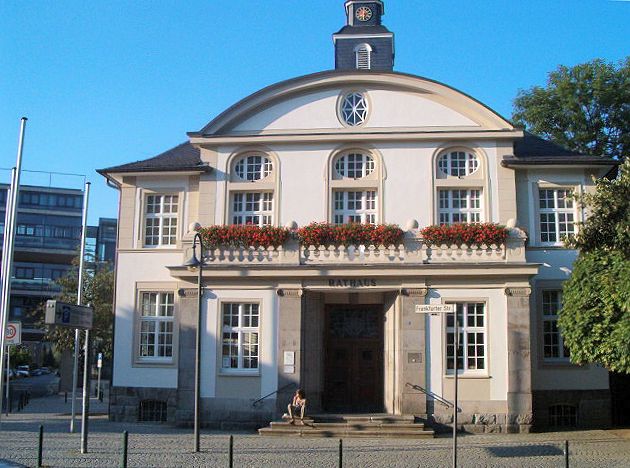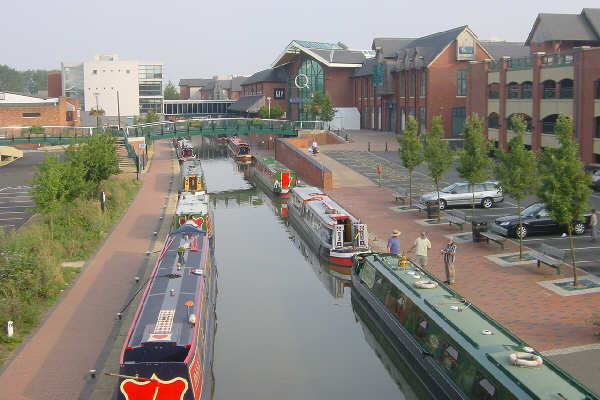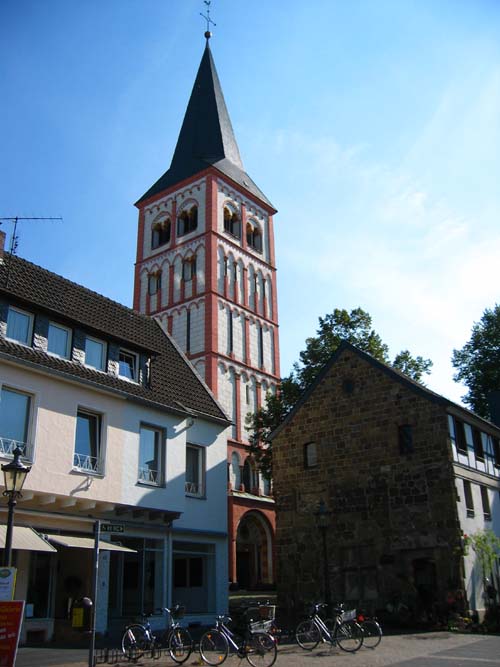|
Hennef
Hennef (Sieg) () is a town in the Rhein-Sieg district of North Rhine-Westphalia, Germany. It is situated on the river Sieg (river), Sieg, approx. south-east of Siegburg and east of Bonn. Hennef is the fourth-biggest town in the Rhein-Sieg-Kreis (i.e. district). It is the site of the 15th-century castle, Schloss Allner, next to the Allner See. Within Hennef is the town of Stadt Blankenberg, with the castle of Blankenberg. Villages in Hennef Hennef is known as the "City of 100 villages". The official list counts 89. List of villages with number of inhabitants in 2024. # Adscheid: 209 # Ahrenbach: 8 # Allner: 1424 # Altenbödingen: 433 # Altglück: 1 # Auel: 83 # Beiert: 12 # Berg: 61 # Blankenbach: 38 # Bödingen: 308 # Bröl: 1332 # Bülgenauel: 245 # Büllesbach: 48 # Büllesfeld: 11 # Dahlhausen: 158 # Dambroich: 671 # Darscheid: 55 # Depensiefen: 7 # Derenbach: 10 # Dondorf: 120 # Dürresbach: 18 # Eichholz: 166 # Eulenberg: 457 # Fernegierscheid: 95 # Greuelsiefen: 448 ... [...More Info...] [...Related Items...] OR: [Wikipedia] [Google] [Baidu] |
Middle Rhine Football Association
The Middle Rhine Football Association (, FVM) is the umbrella organization of the football clubs in the German mid-Rhein area and covers the football districts of Aachen, Berg, Bonn, Düren, Euskirchen, Heinsberg, Cologne, Rhein-Erft-Kreis and Rhein-Sieg-Kreis. The FVM was founded in 1946 and has its headquarters at the Sportschule Hennef. President of the association is Alfred Vianden. The FVM belongs to the Western German Football Association and is one of 21 state organizations of the German Football Association (German: Deutscher Fussball-Bund - DFB). In 2017, the FVM had 364,250 members from 1,126 football clubs with 8,016 teams. The FVM is provider of the Sportschule Hennef. Sportschule Hennef Sportschule Hennef is one of Europe's leading sports schools for football and is also the national training center for boxing and wrestling in Germany. It is the regional training center in North Rhine-Westphalia for weightlifting and judo. Numerous attendances of the Germany ... [...More Info...] [...Related Items...] OR: [Wikipedia] [Google] [Baidu] |
Schloss Allner
Schloss Allner is a fifteenth-century castle in Rhein-Sieg-Kreis, North Rhine-Westphalia, Germany. It is located on the southern slope of the Nutscheid Ridge, on the north bank of the River Sieg, and just northeast of the Allner See. It lies to the northeast of the town of Hennef, east of the district of Allner. During its history it has served as a residence, a municipal seat and an orphanage. During World War II it was the scene of an unsuccessful attempt by the Wehrmacht to halt the advancing Allied forces from crossing the Sieg and entering the Ruhr Valley. Description Formerly surrounded by a moat, the buildings of the cross-shaped four-story mansion, with rectangular towers in the front corners, are crowned by a central lantern roof dating back to the mid-17th century. The front entrance has an 18th-century imperial staircase, edged with balustrades made of trachyte, flanking the original round-arched doorway within a rectangular aperture designed to receive a raised dra ... [...More Info...] [...Related Items...] OR: [Wikipedia] [Google] [Baidu] |
Banbury
Banbury is an historic market town and civil parish on the River Cherwell in Oxfordshire, South East England. The parish had a population of 54,335 at the 2021 Census. Banbury is a significant commercial and retail centre for the surrounding area of north Oxfordshire and southern parts of Warwickshire and Northamptonshire which are predominantly rural. Banbury's main industries are motorsport, car components, electrical goods, plastics, food processing and printing. Banbury is home to the world's largest coffee-processing facility ( Jacobs Douwe Egberts), built in 1964. The town is famed for Banbury cakes, a spiced sweet pastry. Banbury is located north-west of London, south-east of Birmingham, south-east of Coventry and north-west of Oxford. Toponymy The name Banbury may derive from "Banna", a Saxon chieftain said to have built a stockade there in the 6th century (or possibly a byname from meaning ''felon'', ''murderer''), and / meaning ''settlement''. In Anglo Sa ... [...More Info...] [...Related Items...] OR: [Wikipedia] [Google] [Baidu] |
Rütsch
Rütsch is an ''Ortsteil'' (village) in the city of Hennef in the Rhein-Sieg-Kreis, Rhein-Sieg district in North Rhine-Westphalia, Germany. Location The village lies in an altitude ranging from 131 to 167 meters above sea level on the slopes of the Westerwald, but is nevertheless a part of the Natural Park Bergisches Land. Neighbouring villages are Kurenbach and Lichtenberg. History In 1910 there were following households in Rutsch: farmer Maximilian Engels, factory worker Heinrich Meurer, mason Heinrich Stricker and mason Heinrich Wittkopp. In 2024 the village had 26 inhabitants. Until 1 August 1969 the village Rütsch belonged to the Uckerath municipality. As a part of municipal reform of the Bonn area, Uckerath, and thus also the village Rütsch, were assigned to the then-new independent municipality Hennef (Sieg). References [...More Info...] [...Related Items...] OR: [Wikipedia] [Google] [Baidu] |
Walter Von Loë
Friedrich Karl Walter Degenhard Freiherr von Loë (9 September 1828 – 6 July 1908) was a Prussian soldier and aristocrat. Loë had the distinction of being one of the few Roman Catholics to reach the rank of ''Generalfeldmarschall'' (field marshal) in the Prussian and imperial German armies. Biography Walter was born on 9 September 1828 in Schloss Allner, Hennef, to Baron Maximilian von Loë (1801–1850), a chamberlain in the Prussian royal court and chief administrator of the Sieg district in the Rhine Province, and his first wife, Countess Helene von Hatzfeldt-Werther-Schönstein (1801–1838). The House of Loë was an ancient Catholic noble family of Westphalian origin, who was raised to the status of baron of the Holy Roman Empire in 1629. Walter had two younger brothers: Engelbert (1833–1904), and Otto (1835–1892), who would later become a member of the Reichstag. Military career In his youth, Loë was educated at the ''Ritterakademie'' in Bedburg until 1845, ... [...More Info...] [...Related Items...] OR: [Wikipedia] [Google] [Baidu] |
Allner See
Allner See is an artificial lake near Hennef in Rhein-Sieg-Kreis, North Rhine-Westphalia, Germany. At an elevation of 63,5 m, its surface area is 0.10 km2. Directly to the north is the 15th century castle Schloss Allner. Starting in 1979 excavations to obtain sand and gravel for the construction of Highway 560 created a pit some six meters below the water table. In 1986 it was decided by the Hennef town administration to create a lake, and embankments and protection strips were built. In 1990 trees were planted and landscaping was finished just as the highway was completed, producing the lake in its current form. The lake has been stocked with fish for anglers. Swimming is allowed as well as stand-up paddling. But other water sports Water is an inorganic compound with the chemical formula . It is a transparent, tasteless, odorless, and nearly colorless chemical substance. It is the main constituent of Earth's hydrosphere and the fluids of all known living organism ... [...More Info...] [...Related Items...] OR: [Wikipedia] [Google] [Baidu] |
Joseph Dietzgen
Peter Josef Dietzgen (December 9, 1828April 15, 1888) was a German socialist philosophy, philosopher, Marxist, and journalist. Dietzgen was born in Hennef (Sieg), Blankenberg in the Rhine Province of Prussia. He was the first of five children of father Johann Gottfried Anno Dietzgen (1794–1887) and mother Anna Margaretha Lückerath (1808–1881). He was, like his father, a Tanning (leather), tanner by profession, inheriting his uncle's business in Siegburg. Entirely self-educated, he developed the notion of dialectical materialism independently from Karl Marx, Marx and Friedrich Engels, Engels as an independent philosopher of socialist theory. He had one son, Eugene Dietzgen. Life Early on in his youth, Joseph Dietzgen worked with the famed Forty-Eighters of the Revolutions of 1848 in the German states, 1848 German Revolution. It was there that he first met Karl Marx and other socialist revolutionaries, and began his career as a socialist philosopher. Following the failure of ... [...More Info...] [...Related Items...] OR: [Wikipedia] [Google] [Baidu] |
Foley, Alabama
Foley is a city in Baldwin County, Alabama, United States. The 2020 census lists the population of the city as 20,335 Foley is a principal city of the Daphne-Fairhope-Foley metropolitan area, which includes all of Baldwin County. History Foley was named for its founder, John B. Foley of Chicago. As Foley was traveling to President William McKinley's funeral in 1901, he met a railroad agent who told him of the area in South Baldwin County. Foley came down the following year, and liked what he saw, buying between and of land. He then returned to Chicago and formed the Magnolia Springs Land Company, currently known as the Magnolia Land Company. As he began to sell off acreage, he realized the need for a better way for the people to come to Foley. Foley used some of his own money to lay the rails so the train could come from Bay Minette. The first railroad station was built in 1905. The original station burned in 1908 and was replaced the following year by the station that i ... [...More Info...] [...Related Items...] OR: [Wikipedia] [Google] [Baidu] |
Siegburg
Siegburg (; i.e. ''fort on the Sieg (river), Sieg river''; Ripuarian language, Ripuarian: ''Sieburch'') is a city in the district of Rhein-Sieg-Kreis in North Rhine-Westphalia, Germany. It is located on the banks of the rivers Sieg (river), Sieg and Agger (river), Agger, from the former seat of West German government Bonn and from Cologne. The population of the city was 39,192 in the 2013 census. Geography Siegburg is located approximately east of the river Rhine, at the confluence where the Agger (river), Agger joins the Sieg (river), Sieg, in the southeast corner of the Cologne Lowland. Neighbouring towns include Troisdorf, Lohmar, Sankt Augustin and Hennef (Sieg), Hennef. The nearby cities of Cologne and Bonn are easily accessible through good transport links. The highest point of the urban area is above sea level (Normalhöhennull, NHN) in the Braschoß area and the lowest point is just under above sea level at the mouth of the Agger (river), Agger. History Archbishop ... [...More Info...] [...Related Items...] OR: [Wikipedia] [Google] [Baidu] |
Ranga Yogeshwar
Ranganathan Gregoire Yogeshwar (born 18 May 1959) is a Luxembourgish physicist and science journalist based in Germany. He started gaining attention at the end of the 1980s in the German-speaking area for his science documentaries that were often coupled with critical analysis and prognoses of the societal effects of research in the natural sciences. Early life and education Yogeshwar grew up in Bangalore, India and Luxembourg and went to primary school in both places. His father is an Indian engineer and his mother a Luxembourgish art historian. He has a younger sister and a twin brother, Pierre Kalyana Yogeshwar, who is also a physicist. His grandfather was mathematician and librarian S. R. Ranganathan, the developer of the colon classification. Growing up, he spoke Luxembourgish, German, French, English, Tamil, Kannada, Hindi and Malayalam (the latter three to communicate with his housekeeper, teacher, and gardener, respectively). Yogeshwar studied music in Luxembourg and ... [...More Info...] [...Related Items...] OR: [Wikipedia] [Google] [Baidu] |
Hank Levine
Hans-Werner Maria Levy (born 29 June 1965), better known as Hank Levine, is a German director, documentary filmmaker and writer based in Berlin, Germany. He is known for producing Academy Awards nominated films such as '' City of God'' and '' Wasteland''. Early life Levine was born in Bonn, West Germany in 1965 and spent his childhood years in Hennef (Sieg). He graduated from high school in 1985 and studied law at the university town of Marburg for a few semesters. Between 1988 and 1990, he attended University of Bonn where he studied Economics. From 1990 to 1993, Levine attended Free University of Berlin where he studied journalism. From 1994, Levine attended University of California, Los Angeles's Extension Program where he studied advertising and feature film production. Career During his time at UCLA, Levine started shooting avant-garde short films and in 1993, he directed his first short film ''The Flying Dutchmen'' which premiered at the 43rd Berlin International Film Fest ... [...More Info...] [...Related Items...] OR: [Wikipedia] [Google] [Baidu] |
What Is Love
"What Is Love" is a song by Trinidadian-German singer Haddaway, released as his debut single from his debut album, ''The Album (Haddaway album), The Album'' (1993). The song, both written and produced by Tony Hendrik, Dee Dee Halligan and Karin Hartmann-Eisenblätter, was released by Tony Hendrik#Coconut Records, Coconut Records in January 1993. It was a hit across Europe, becoming a number-one single in at least 13 countries and reaching number two in Germany, Sweden and the United Kingdom. Outside Europe, the single peaked at number 11 in the United States, number 12 in Australia, number 17 in Canada, and number 48 in New Zealand. "What Is Love" earned Haddaway two awards at the German 1994 Echo Music Prize, Echo Award, in the categories "Best National Single" and "Best National Dance Single." The music video for "What Is Love" was directed by Volker Hannwacker and received heavy rotation on music television such as MTV Global, MTV Europe. The song remains Haddaway's most popul ... [...More Info...] [...Related Items...] OR: [Wikipedia] [Google] [Baidu] |




